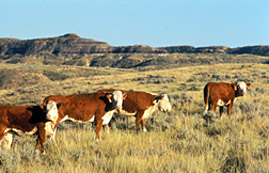This page has been archived and is being provided for reference purposes only. The page is no longer being updated, and therefore, links on the page may be invalid.
A Futuristic Linkage of Animals and Electronics
By Don ComisJune 6, 2008
The same Global Positioning System (GPS) technology used to track vehicles is now being used to track cows.
But Agricultural Research Service (ARS) animal scientist Dean M. Anderson has taken tracking several steps further with a Walkman-like headset that enables him to "whisper" wireless commands to cows to control their movements across a landscape—and even remotely gather them into a corral.
He and his colleagues realize this is a highly futuristic technology, but they can envision a time when these technologies will be affordable and useful for a range of applications, from intensive animal operations to monitoring and controlling the movements of some wildlife species and even household pets.
Anderson, at the ARS Jornada Experimental Range in Las Cruces, N.M., is working with Daniela Rus and a team of engineers at the Massachusetts Institute of Technology in Cambridge to equip an Ear-A-Round (EAR) device with state-of-art electronics. Their latest prototype is a doughnut-shaped stereo headset worn over each ear. Anderson’s headset design and his knowledge of range animal ecology have been combined with the MIT scientists' electronics skills in robotics and mobile computing.
Prior to working with MIT, Anderson patented technology for virtual fencing termed Directional Virtual Fencing (DVF) that centered around giving cows "left" and "right" sensory signals to cause them to move away from an irritating suite of cues.
The researchers at MIT's Computer Science and Artificial Intelligence Laboratory have developed and prototyped a miniaturized electronics package for DVF devices that is solar- powered and is packaged as a headset device. The circuit board contains a processor, data storage, WiFi for remote communication, audio and electrical stimulation electronics, a GPS receiver, and sensors such as magnetometers and accelerometers that record the body orientation and configuration of the animal.
The commands vary from familiar “gathering songs” sung by cowboys during manual round-ups, to irritating sounds such as sirens and even mild electric stimulation if necessary to get cows to move or avoid penetrating forbidden boundaries.
ARS is a scientific research agency of the U.S. Department of Agriculture .

